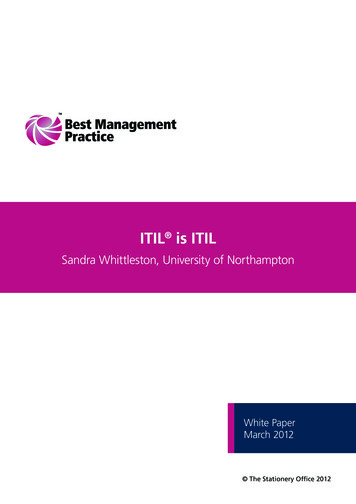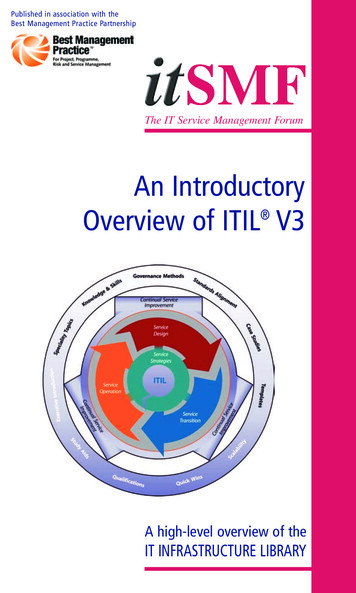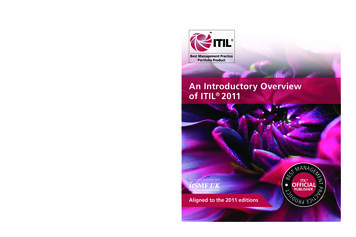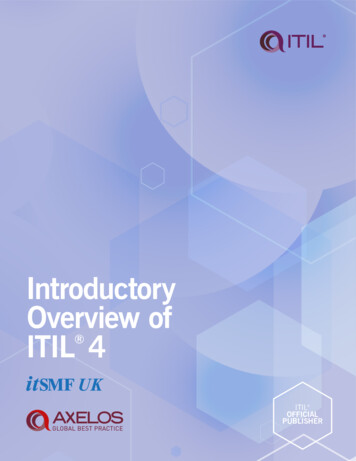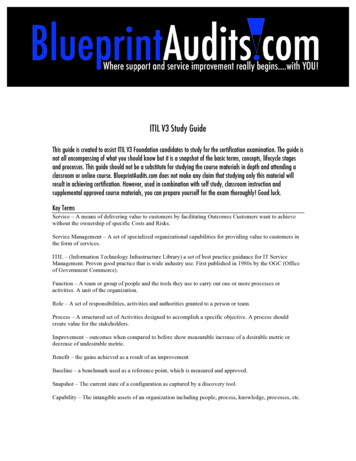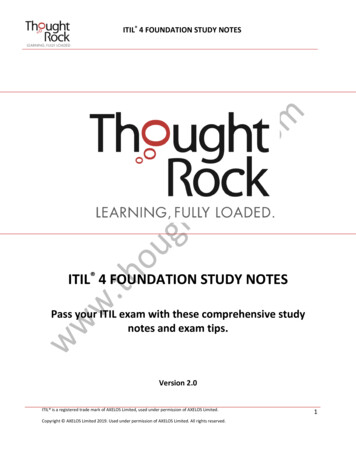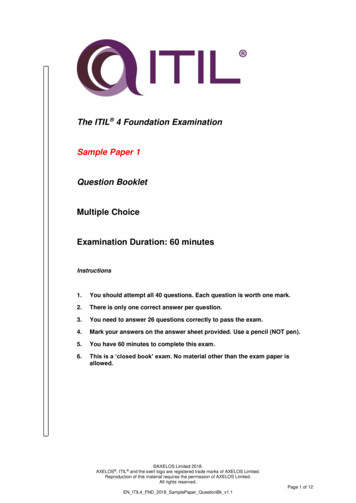
Transcription
An Overview of theITIL Maturity Modelaxelos.comSeptember2021
2ContentsAcknowledgements31Introduction42ITIL maturity model overview83Selecting an assessment approach244Validation and benchmarking25Appendix 1. ITIL management practices26Appendix 2. The ITIL guiding principles29Appendix 3. ITIL continual improvement model30
An Overview of the ITIL Maturity ModelAcknowledgementsAxelos Ltd is gratef ul to the f ollowing f or the time and ef f ort they have put into the development ofthis release of the ITIL Maturity Model set of guidance and tools.AuthorsDinara Adyrbai, Pavel Demin, Adam Grif f ith, Roman Jouravlev, Stuart RanceReviewersAbdelelah Alzaghloul, Digital Applications; Akshay Anand; Jason Beasley, Leidos ; David Billouz,Ociris; Joanne Boucher; Richard Browning; David Cannon; Erin Casteel, Veridity Pty Ltd; Erika Flora,Beyond 20; Michelle Goldsmith, Kinetic IT; Dmitry Isaychenko; Simon Kent, Quantum Twenty One;Anton Lykov, Micro Focus; Nigel Mear, Solid Air Consultancy; Nigel Murphy, Vodaphone; KonstantinNaryzhny, Tata consultancy services; Mitchell Pautz, University of southern Calif ornia; Mark Smalley,Smalley IT; Nargiza Suleyman, Expert Pro; Doug Tedder, Tedder Consulting; Andrew Turner; DavidWright, The Service Desk Institute.Exam question writersStuart Rance; Nicola ReevesDigital tool contributors Alpha TestingAbdelelah Alzaghloul, Digital Applications; Mark Blanke, Owl Point LLC; Jack Beswick, PAConsulting; Greg Smith, Owl Point LLC; Doug Tedder, Tedder Consulting; Shaun Wiggett, PAConsultingDigital tool contributors Beta TestingMark Blanke, Owl Point LLC; Stuart Rance, Optimal Service Management: Greg Smith, Owl PointLLC;ITIL MM beta exam candidatesAbdelelah Alzaghloul; Benjamin Bartine; David Billouz; Jason Beasley; Mark Blanke; JoanneBoucher; Richard Browning; Karen Brusch; Erin Casteel: Sethuraman Chandrasekaran; Rob Colley;David Crouch; Simon Dorst; Peter Farenden; Erika Flora; Wael Hosny; Sam Jacob George; TayyabJamil; Kamal Kamboj; Anton Lykov; Irina Matantseva; Nigel Mear; Nargis Mirza; Nigel Murphy; DeviNair; Vinod Nair; Kulpreet Nanda; Konstantin Naryzhnyi; Alim Ozcan; Fatma Ozcan; Nas Ozcan;Stuart Rance; Pratibha Ramesh; Nicola Reeves; Oleg Skrynnik; Nargiza Suleymanova; DougTedder; Andrew Turner; Tejinder VirdiProject teamMargo LeachChief Product Of f icerJoanna FejklowiczProject ManagerCorina CanavanSenior Product ManagerJames PatrickProduct OwnerRoman JouravlevProduct Development Manager, ITILAdam Grif f ithConsultant, IT Best PracticeDavid AtkinsContent Delivery ManagerSarah ConnerSenior Production EditorJames RobertsonSenior Qualif ication Assessment SpecialistZara SwaleQualif ication Assessment SpecialistAXELOS and ITIL are registered Trade Mark of AXELOS LimitedThe swirl logo is a trademark of AXELOS Limited Copyright AXELOS Limited 2021. All rights reserved.3
An Overview of the ITIL Maturity Model1Introduction1.1 AUDIENCEThis document describes the purpose, architecture, and key elements of the ITIL maturity model. Itis addressed to consultants, assessors, leaders, managers, and practitioners involved in orconsidering the use of the model.The purpose of the document is to present and explain the ITIL maturity model and enable itsapplication in practice.The model is based on ITIL 4 and uses ITIL 4 terms and concepts. However, readers are notexpected to be prof icient in ITIL 4. Foundation-level knowledge of IT service management issuf f icient f or understanding the document and making decisions regarding the use of the model.Assessors are expected to possess deeper knowledge of ITIL 4 practices. Eligibility criteria can bef ound in the Axelos Consulting Partner Programme Scheme Brochure.1.2 PURPOSEThe ITIL maturity model is a tool that organizations can use to objectively and comprehensivelyassess their service management capabilities and the maturity of the organization’s service valuesystem (SVS).The primary intended purpose of such assessments is to inf orm the organization’s improvementplanning by highlighting the areas that need improvement.Other relevant purposes include: monitoring the progress of improvements to the organization’s capabilities and maturity understanding how an organization’s capabilities and maturity compare to those of otherorganizations (benchmarking) obtaining a f ormal conf irmation of the organization’s ability to act as an ef f ective service provider(validation/certif ication).The applicability of these purposes and the validity of the assessment results are subject to theassessment’s scope, independence, and adherence to the recommended assessment process.The assessment of the organization’s service management capability is based on evidence of thef ulf ilment of defined criteria relating to the 34 ITIL management practices. The assessment of theorganization’s maturity is based on evidence of the f ulf ilment of criteria relating to the f ive keycomponents of the organization’s SVS.Key messageAlthough the ITIL maturity model is based on the architecture and concepts of ITIL 4, it is NOTdesigned to assess the extent or success of implementation of the ITIL guidance. Bothpractices and SVS components can be assessed in organizations that have been developingtheir service management capabilities and management systems using any relevant guidanceand sources of good practice.Appendix 1 provides an overview of the ITIL management practices; Appendix 2 and Appendix 3describe ITIL guiding principles and the ITIL continual improvement model respectively.AXELOS and ITIL are registered Trade Mark of AXELOS LimitedThe swirl logo is a trademark of AXELOS Limited Copyright AXELOS Limited 2021. All rights reserved.4
An Overview of the ITIL Maturity ModelKey messageCapability and maturity assessments are not the only types of assessments an organizationmight need. The ITIL maturity model is not designed to assess the: ef f ectiveness of the organization’s practices or SVS (whether they achieve the agreedobjectives) ef f iciency of the organization’s practices or SVS (whether they achieve the agreedobjectives in an optimal and cost-ef f ective way) compliance to any regulations or standards progress of any organizational initiatives, unless they aim to improve service managementcapabilities or the maturity of the organization’s governance and management system.These and other types of assessment may be relevant and valuable f or an organization andshould be considered along with the capability and maturity assessments, depending on theobjectives and context of the organization.1.3 ITIL MATURITY MODEL COMPONENTS AND SUPPORTING MATERIALSThe ITIL maturity model includes the f ollowing components: the model overview (this document) the ITIL management practices’ capability assessment criteria the SVS maturity criteria.Supporting materials f or the ITIL maturity model include the: assessment guide: assessment process description scoping guidance ACP scheme brochure: requirements f or the consulting organizations requirements f or the assessors registration process validation/certif ication process (please ref er to the Organization Maturity Level Certif ication guidance)sample exam materials.1.4 ITIL MATURITY MODEL AND OTHER ITIL COMPONENTSThe ITIL maturity model is based on components of the ITIL 4 f ramework.1.4.1 ITIL management practicesITIL 4 describes 34 management practices.Definition: Management practiceA set of organizational resources designed f or perf ormingwork or accomplishing an objective.The model provides tools for assessing the management practices’ capabilities (assessing whetheror not they f ulf il their purposes).AXELOS and ITIL are registered Trade Mark of AXELOS LimitedThe swirl logo is a trademark of AXELOS Limited Copyright AXELOS Limited 2021. All rights reserved.5
An Overview of the ITIL Maturity ModelFor each practice, a set of practice success f actors (PSFs) is def ined.A PSF is more than a task or activity; it includes components f rom all f our dimensions of servicemanagement (see section 1.4.2). The nature of the activities and resources of PSFs within a practicemay dif f er, but together they ensure the ef f ectiveness of the practice.The practices are listed in Appendix 1, along with their purposes. Full practice guides are availableonline. 11.4.2 The four dimensions of service managementTo support a holistic approach to service management, ITIL def ines f our dimensions that collectivelyare critical f or the ef f ective and ef f icient co-creation of value f or customers and other stakeholders inthe f orm of products and services. The dimensions are: organizations and peopleinf ormation and technologypartners and suppliersvalue streams and processes.These f our dimensions represent perspectives which are relevant to the whole SVS, including theentirety of the service value chain and all of the ITIL practices. The f our dimensions are constrainedor inf luenced by several external f actors that are of ten beyond the control of the SVS.Fig ure 1. 1 The f o ur d imens io ns o f s erv ic e manag ementThe capability criteria def ined in the ITIL maturity model are mapped to each practice’s PSFs and thef our dimensions of service management. This allows the assessor to assess the practices holisticallyrather than f ocusing on one or two aspects, such as processes or technology.1.4.3 SVS componentsFor service management to f unction properly, it needs to work as a system.The ITIL SVS describes how all the components and activities of the organization work together as asystem to enable value creation. Each organization’s SVS has interf aces with other organizations,1www.axelos.com/prof -axelos-content-hub?c itil4practices [My ITIL subscription required]AXELOS and ITIL are registered Trade Mark of AXELOS LimitedThe swirl logo is a trademark of AXELOS Limited Copyright AXELOS Limited 2021. All rights reserved.6
An Overview of the ITIL Maturity Modelf orming an ecosystem that can in turn f acilitate value creation f or those organizations, theircustomers, and other stakeholders.Fig ure 1. 2 The ITIL s erv ic e v alue s y s t emThe key inputs to the SVS are opportunity and demand. Opportunities represent chances to addvalue f or stakeholders or otherwise improve the organization. Demand is the need or desire f orproducts and services among internal and external consumers. The outcome of the SVS is value: theperceived benef its, usef ulness, and importance of something. The ITIL SVS can enable the creationof many dif f erent types of value f or a wide group of stakeholders.The ITIL SVS includes the f ollowing components: Guiding principles Recommendations that can guide an organization in all circumstances, regardless of changes in its goals, strategies, type of work, or management structure.Governance The means by which an organization is directed and controlled.Service value chain A set of interconnected activities that an organization perf orms to deliver avaluable product or service to its consumers and to f acilitate value realization.Practices Sets of organizational resources designed f or perf orming work or accomplishing anobjective.Continual improvement A recurring organizational activity perf ormed at all levels to ensure thatan organization’s perf ormance continually meets stakeholders’ expectations. ITIL 4 supportscontinual improvement with the ITIL continual improvement model.The purpose of the SVS is to ensure that the organization continually co-creates value with allstakeholders through the use and management of products and services.The ITIL maturity model def ines criteria to assess the organization’s SVS maturity based on all keycomponents of the SVS, combined with the capability level demonstrated by the managementpractices in scope of the assessment.Note: even if an organization has not f ormally adopted the terminology and models of ITIL 4, thescope of maturity assessment remains the same. To work ef f ectively, an organization’sgovernance and management system needs to develop and maintain the f ive components listedabove. It is assumed that only when all f ive components demonstrate certain levels of maturity,the organization and its stakeholders can be reasonably assured of the organization’s ability toachieve its goals.AXELOS and ITIL are registered Trade Mark of AXELOS LimitedThe swirl logo is a trademark of AXELOS Limited Copyright AXELOS Limited 2021. All rights reserved.7
An Overview of the ITIL Maturity Model2ITIL maturity model overviewThe ITIL maturity model provides tools for assessing the management practices’ capability and thematurity of the organization’s SVS. The f ollowing rules apply: The scope of a maturity assessment includes f ive SVS components (see Sections 2.3.2 – 2.3.6). The maturity of the ‘practice’ component of the SVS is def ined based on the capability assessmentof the practices in scope. The continual improvement practice is included in every maturity assessment. Other practices in scope are def ined when the assessment is planned, depending on its objectives.To ensure a valid and representative assessment of the practices as a part of the organization’sSVS, it is recommended to include at least seven practices in the scope of a maturity assessment.Generally, maturity assessments are more representative and applicable to the organization as awhole when more practices are in scope.Organizations can perf orm capability assessments using any number of individual practiceswithout assessing the SVS components; f or example, to support the improvement of the selectedpractices.2.1 ASSESSING CAPABILITY2.1.1 Capability levelsThe f ollowing scale of the capability levels applies to every management practice: Level 1 The practice is not well organized; it is perf ormed as initial/intuitive. It may occasionally orpartially achieve its purpose through an incomplete set of activities. Level 2 The practice systematically achieves its purpose through a basic set of activitiessupported by specialized resources. Level 3 The practice is well def ined and achieves its purpose in an organized way, using dedicated resources and relying on inputs f rom other practices that are integrated into a servicemanagement system.Level 4 The practice achieves its purpose in a highly organized way, and its perf ormance iscontinually measured and assessed in the context of the service management system.Level 5 The practice is continually improving organizational capabilities associated with itspurpose.Each capability level is based on the previous ones; they need to be achieved bef ore the currentlevel can be assessed.2.1.2 Capability criteriaFor each practice, a number of capability criteria are def ined f or each capability level, f rom level 2 tolevel 5. For example, criteria mapped to capability level 2 describe the f unctional capabilitiessupporting the achievement of the practice’s purpose; criteria mapped to level 5 describe thecapabilities supporting the practice’s contribution to the continual improvement of the organization.The capability criteria developed f or each practice are designed to ensure that capability assessmentcomprehensively covers the practice’s ability to achieve its purpose. To achieve this, the criteria arebased on the practice’s PSFs: f or each PSF, an average of 5-6 criteria are def ined. By def inition, thef ulf ilment of the practice’s PSF ensures the f ulf ilment of the practice’s purpose. In turn, f ulf ilment ofthe PSF can be conf irmed by meeting all criteria def ined f or the PSF.AXELOS and ITIL are registered Trade Mark of AXELOS LimitedThe swirl logo is a trademark of AXELOS Limited Copyright AXELOS Limited 2021. All rights reserved.8
An Overview of the ITIL Maturity ModelFig ure 2. 1 D es ig n o f t he c ap ab ilit y c rit eriaEach criterion is mapped to one of the f our dimensions of service management and to the supportedcapability level. The higher the capability level, the more comprehensive realization of the practice isexpected. For example, criteria related to the practice automation are typically def ined at levels 3 andhigher because ef f ective automation is only possible if the practice is well def ined and organized.The described approach to def ining the capability criteria results in every practice having up to 30criteria based on the practice PSF’s and mapped to the f our dimensions of service management. Thenumber of criteria at each level dif f ers: the f our dimensions are comprehensively covered startingf rom level 3, so this level typically has more criteria than others.2.1.3 Identifying capability levelThe overall capability level of the practice is def ined by the highest level f or which all capabilitycriteria are met. For example, if all criteria mapped to level 3 are met, and only some of the criteriamapped to levels 4 and/or 5 are met, then the overall capability level of the practice is assessed as 3.CapabilitylevelPSFCriteriaPractice namePSF1PSF1 namePSF1CriterionDimensionValue streams and processes2PSF1CriterionValue streams and processes2PSF1CriterionInf ormation and technology3PSF2PSF2PSF2 nameCriterionInf ormation and technology3PSF2CriterionValue streams and processes3PSF2PSF2CriterionPSF3 name Partners and suppliers4If all criteria up to a certainlevel are met, the capabilitylevel is achieved}3Capability level achievedFigure 2.2 Identif ying capability levelOn average, 5-6 capability criteria are def ined f or each PSF. No criteria are mapped to capabilitylevel 1. The overall practice’s capability level is assessed as 2 if all level 2 criteria are met; if moreAXELOS and ITIL are registered Trade Mark of AXELOS LimitedThe swirl logo is a trademark of AXELOS Limited Copyright AXELOS Limited 2021. All rights reserved.9
An Overview of the ITIL Maturity Modelthan half of them are met, the overall capability level is assessed as 1; if f ewer than half of the level 2criteria are met, the overall capability level is not assigned. 22.1.4 Evidence of meeting the capability criteriaA practice’s ability to meet each of the capability criteria should be demonstrated by evidencecollected during the assessment. The evidence should be relevant, verif iable, and objective.Typically, evidence is presented in the f orm of documents, records, and interview/survey statementscollected by the assessor.The assessor’s guide includes indicative checklists of the most common documents and recordsassociated with the capability criteria. As the most generic suggestion, the lists of inputs and outputsprovided in section 3.2 of each ITIL management practice guide can be used. (Note that these listsare mapped to the processes def ined f or the practice, not to the PSFs or the capability criteria.)2.2 EXAMPLES OF THE PRACTICE CAPABILITY CRITERIA2.2.1 Service request managementThe purpose of the service request management practice is to support the agreed quality of a serviceby handling all predef ined, user-initiated service requests in an ef f ective and user-f riendly manner.Table 2.1 outlines examples of capability criteria f or the service request management practice.2When an overall capability level is not assigned, it is ref lected in diagrams and calculations as zero.AXELOS and ITIL are registered Trade Mark of AXELOS LimitedThe swirl logo is a trademark of AXELOS Limited Copyright AXELOS Limited 2021. All rights reserved.10
An Overview of the ITIL Maturity ModelTable 2.1 Examples of capability criteria for the service request management practiceCapabilitylevelPSFCapability criterionDimensionEnsuring that theservice requestf ulf ilmentprocedures f or allservices areoptimizedService request f ulf ilment procedures aredef ined and agreed f or the key userf acing servicesValue streams and 2processesResponsibilities f or request f ulf ilment areclearly def inedValue streams and 3processesService request f ulf ilment procedures arealigned with relevant standards andapproaches adopted by the organizationValue streams and 4processesThe ef f ectiveness of the service requestf ulf ilment procedures is monitored andevaluatedValue streams and 4processesService request f ulf ilment procedures areregularly reviewed and continuallyimprovedValue streams and 5processesEnsuring that allService requests are usually f ulf illedservice requests are within agreed service levelsf ulf illed according to User satisf action with f ulf ilment of servicethe agreedrequests is measured and reportedprocedures and toThe competencies required to f ulf il anduser satisf actionmanage service requests are identif ied,and qualif ied human resources areavailableValue streams and 2processesValue streams and 2processesOrganizations andpeople3Communication and other technologysolutions to f ulf il and manage servicerequests are identif ied and implementedInf ormation andtechnology3Third-party services required to f ulf il andmanage service requests are identif iedand availablePartners andsuppliers3The ef f ectiveness, ef ficiency, and usersatisf action with request f ulf ilment aremeasured and assessed in the context ofthe value streamsValue streams and 4processesRequest f ulf ilment is regularly reviewedand continually improvedValue streams and 5processes2.2.2 Strategy managementThe purpose of the strategy management practice is to f ormulate the goals of the organization andadopt the courses of action and allocation of resources necessary f or achieving those goals. Strategymanagement establishes the organization’s direction, f ocuses ef f ort, defines or clarif ies theorganization’s priorities, and provides consistency or guidance in response to the environment.Table 2.2 outlines examples of capability criteria f or the strategy management practice.AXELOS and ITIL are registered Trade Mark of AXELOS LimitedThe swirl logo is a trademark of AXELOS Limited Copyright AXELOS Limited 2021. All rights reserved.11
An Overview of the ITIL Maturity ModelTable 2.2 Examples of capability criteria for the strategy management practiceCapabilitylevelPSFCapability criterionDimensionEnsuring that theorganization'sstrategies areef f ective andsustainable, andmeet thestakeholders'evolving needsOrganization’s strategies meetstakeholders’ requirementsValue streams andprocesses2Strategies are explored at distinctintervals and kept up to dateValue streams andprocesses2Strategies are created with multiplestakeholders engaged f rom relevantparts of the organizationValue streams andprocesses2Third-party dependencies andrelationships are included in theorganization’s strategiesPartners and suppliers3The organizational culture isaccounted f or and supported by theorganization’s strategiesOrganizations andpeople3The competencies required to createand manage strategies are identif ied,and qualif ied human resources areavailableOrganizations andpeople3The role and application of digitaltechnology are included in theorganization’s strategiesInf ormation andtechnology3The organization’s strategies areinterconnected and consistentlysupport the organization’s vision andmissionValue streams andprocesses4The organization’s strategicinf ormation is tracked and managed inan integrated inf ormation systemInf ormation andtechnology4The organization’s strategies andapproach to strategy management areregularly reviewed and continuallyimprovedValue streams andprocesses5Strategies and plans arecommunicated across theorganization and available to relevantstakeholdersValue streams andprocesses2Members of the organization knowand support the relevant strategiesOrganizations andpeople2Plans and initiatives across theorganization are aligned with theagreed strategiesValue streams andprocesses3The progress of the strategies’realization is monitored and reportedto relevant stakeholdersValue streams andprocesses3The adoption and execution of thestrategies are ef f ectively supported byrelevant practicesValue streams andprocesses3Relevant third parties are aware ofand involved in the realization of theorganization’s strategiesPartners and suppliers3Progress of the strategies’ realizationis monitored and reported using anInf ormation andtechnology4Ensuring that theagreed strategiesand models arecommunicatedacross theorganization andembedded into theorganizations'practices and valuestreamsAXELOS and ITIL are registered Trade Mark of AXELOS LimitedThe swirl logo is a trademark of AXELOS Limited Copyright AXELOS Limited 2021. All rights reserved.12
An Overview of the ITIL Maturity ModelPSFCapability criterionDimensionCapabilitylevelintegrated inf ormation systemThe adoption and realization of theorganization’s strategies arecontinually reviewed and improvedValue streams andprocesses52.3 ASSESSING MATURITYThe SVS’s maturity is calculated based on the results of SVS component assessments. The overallmaturity level of the SVS is def ined as the lowest level achieved by an individual component. Forexample, if the governance component’s maturity is assessed as level 2 and all the othercomponents demonstrated higher levels of maturity, the overall SVS maturity is at level 2.The maturity of the f ollowing two components of the SVS is assessed based on the results of thecapability assessment: Practices and Continual improvement. See sections 2.3.5 and 2.3.6 f ordetails.2.3.1 Maturity levelsWhen assessing the maturity level of each of the SVS components, assessors judge the suf f iciencyof the evidence supporting each level. Details of the evidence suf f iciency and justif ication of thematurity level conclusion must be included in the assessment report provided to the customer. Thef ollowing maturity levels are def ined f or the SVS: Level 1, Initial Work is completed, but the purpose and objectives of the SVS in scope are not always achieved.Level 2, Managed Planning and perf ormance measurement take place, and the purpose andobjectives of the SVS in scope are repeatedly achieved, although not in a standardized way.Level 3, Defined Organization-wide standards provide guidance across the SVS.Level 4, Quantitative The SVS is data driven, with quantitative perf ormance evaluation.Level 5, Optimizing The SVS is optimized and f ocused on continual improvement.Each maturity level is based on the previous ones; they need to be achieved bef ore the current levelcan be assessed. This applies to all descriptions of the maturity levels in Sections 2.3.2 – 2.3.6.AXELOS and ITIL are registered Trade Mark of AXELOS LimitedThe swirl logo is a trademark of AXELOS Limited Copyright AXELOS Limited 2021. All rights reserved.13
An Overview of the ITIL Maturity ModelFigure 2.3 The SVS components and maturity levels assessedThese generic criteria are applied to the f ive components of the organization’s SVS in scope: guiding principlesgovernanceservice value chainpracticescontinual improvement.Brief descriptions of the SVS components are provided in the f ollowing sections, together with thedef initions of the maturity levels adjusted to ref lect the specif ics of each component.AXELOS and ITIL are registered Trade Mark of AXELOS LimitedThe swirl logo is a trademark of AXELOS Limited Copyright AXELOS Limited 2021. All rights reserved.14
An Overview of the ITIL Maturity Model2.3.2 Guiding principles2.3.2.1 OverviewDef inition: Guiding principleA recommendation that guides an organization in all circumstances, regardless of changes in itsgoals, strategies, type of work, or management structure. A guiding principle is universal andenduring.The seven ITIL guidance principles are listed and described in Appendix 2. Further inf ormation canbe f ound in ITIL Foundation: ITIL 4 Edition 3, Section 4.3.The ITIL guiding principles embody the core messages of ITIL and of service management ingeneral, supporting successf ul actions and good decisions of all types and at all levels. They can beused to guide organizations in their work as they adopt a service management approach and adaptITIL guidance to their own specif ic needs and circumstances. The guiding principles encourage andsupport organizations in continual improvement at all levels.However, another set of guiding principles can be adopted by the organization. The maturityassessment is not f ocused on the adoption of the seven ITIL guiding principles; rather, it helps tounderstand the role and maturity of shared values and principles across the organization.2.3.2.2 Maturityassessment of the guiding principlesThe f ollowing levels are def ined f or the maturity assessment of the guiding principles: Level 1 Key people 4 have dif f erent views on values and guiding principles, which might conf lict. Level 2 Common values and guiding principles are shared by key people and articulated in asimilar way; however, they are communicated mostly inf ormally, by word of mouth. Level 3 Common values and guiding principles are documented and of ficially declared; mostpeople are aware of them and agree with them. Level 4 Common values and guiding principles are integrated into the organization’s activities and decision-making at f ormal and inf ormal levels; they are communicated and promoted across theorganization. Adherence to the values and guiding principles is systematically monitored andevaluated.Level 5 Common values and guiding principles are consistently applied across the organization,but also are continually and systematically reviewed and may be challenged or conf irmed.2.3.3 Governance2.3.3.1 OverviewEvery organization is directed by a governing body: a person or group of people who are accountableat the highest level f or the perf ormance and compliance of the organization. All sizes and types oforganization perf orm governance activities; the governing body may be a board of directors orexecutive managers who take on a separate governance role when they are perf orming governanceactivities. The governing body is accountable f or the organization’s com
The ITIL maturity model defines criteria to assess the organization’s SVS maturity based on all key components of the SVS, combined with the capability level demonstrated by the management practices in scope of the assessment. Note: even if an organization has not formally adopted t

